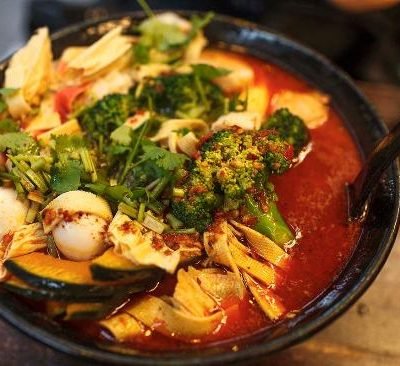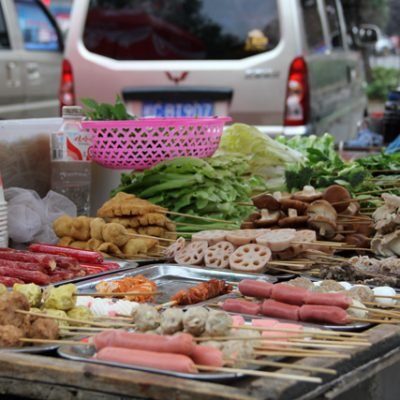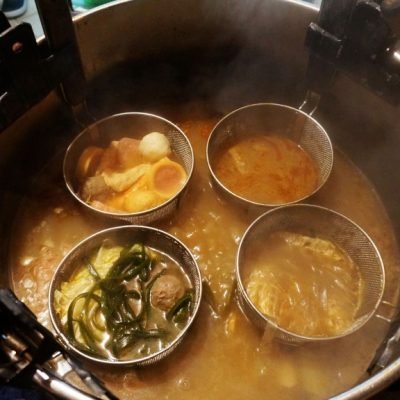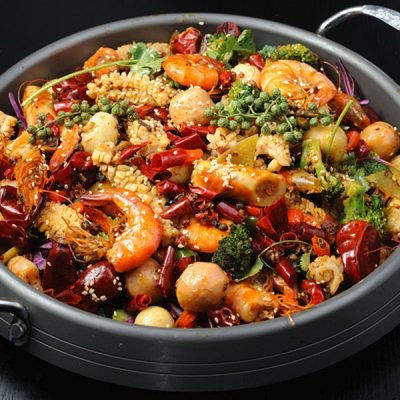Malatang (simplified Chinese: 麻辣烫; traditional Chinese: 麻辣燙; pinyin: málàtàng; literally: “spicy numbing hot [soup]”), is a common type of Chinese street food that is especially popular in Beijing but can be found all over China. It originated in Sichuan Province, but the regional varieties differ mainly from the Sichuanese version in that the Sichuanese version is more similar to what in northern China would be described as hot pot.
Malatang is named after its key ingredient, mala sauce, which is flavored with a combination of Sichuan pepper (which represents the “ma” or the numbing flavor) and dried chili pepper (which represents the “la” or the spicy sauce) . The word málà is composed of the Chinese characters for “numbing” (麻) and “spicy (hot)” (辣), referring to the feeling in the mouth after eating the sauce.
Malatang is said to originate from the Yangtze River near Sichuan. In ancient times, boating was a big industry and many people made a living by towing boats. Working under the damp and foggy weather made boat trackers feel very sick. And when they were hungry, they cooked herbs in a pot and put Sichuan pepper and ginger into the soup to eliminate dampness. Malatang was created, then vendors discovered the business opportunity, and spread it throughout China. And now it is becoming an international food sensation.
Unlike hot pot, which is made to order and shared only by diners at a private table, malatang originates from street food cooked in a communal pot. Diners can quickly pick their raw veggies and noodles and meats, and either eat on the spot or take away. In addition to largely being considered a street food in China, there have been many excellent chain restaurants that have sprung up in the last 10 years and these restaurants offer a great variety of sauces and ingredients (as you can see in the video above).
Skewers
All skewers normally cost the same. In Beijing as of June 2012 they cost one RMB each (or about 1/6 of a US dollar). Customers keep the used wooden sticks by their plates, and when a customer finishes eating, the price to pay is determined by counting the number of empty sticks.
By weight
In the mid-2010s malatang shops became popular in North China, especially Beijing. In these shops the ingredients are usually displayed on shelves, and customers put their desired ingredients into a bowl, like choosing food from a buffet. Behind the counter the selected ingredients are cooked in a spicy delicious savory broth, usually at very high temperature for 3–4 minutes. Before serving, malatang is typically further seasoned with lots of garlic, black pepper, Sichuan pepper, chili pepper, sesame paste, and crushed peanuts (and these condiments can also be prepared in a separate side dish that makes for very enjoyable dipping ). The price is calculated based on the weight of the self-selected ingredients (just as you would weigh a frozen yoghurt and pay based on weight at the counter). In Beijing, one person’s bowl might weigh half a kilogram usually costs between 15-20 RMB as of November 2015. And most malatang bowls outside of Beijing also cost around 15 RMB, making this a very affordable and interesting option for lunch or dinner. And- if you are feel like sharing, you and 1-2 other friends can lump all your ingredients in one huge communal bowl and can eat the same soup out of one pot. That is what all the besties and couples in China do, anyway 🙂
Common ingredients
Here is the stuff you usually get to pick from in this “Choose Your Own Adventure” soup:
- bean curd
- beef (chunks)
- dumplings
- fish balls
- lettuce
- spinach
- broccoli
- other mixed greens (including cilantro, cabbage, and onions)
- lotus root
- all sorts of mushrooms
- fresh and instant noodles
- pork liver
- pork lung
- fresh seaweed
- potato slices
- quail eggs
- Spam
- Chinese yam
- sheep intestines
- numerous types of dried and frozen tofu (chunks, squares, balls, etc.)
- various flat and long noodles made from potato and rice powder
- nian gao rice cakes
So there you go! I hope you get out into some local markets and try this amazing culinary delight!












